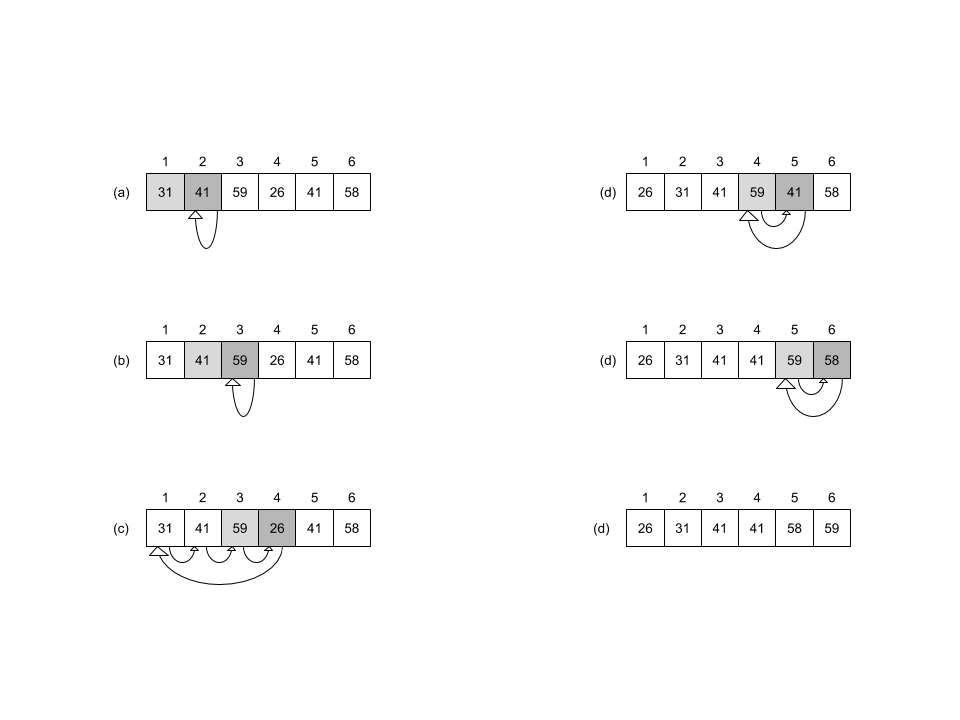Chapter 2 — Getting Started
2.1 Insertion sort
2.1-1
An illustration of the INSERTION-SORT procedure on the array \(A=\left \langle 31, 41, 59, 26, 41, 58 \right \rangle\).

2.1-2
A version of INSERTION-SORT that sorts into nonincreasing order follows.
INSERTION-SORT(A)
for j = 2 to A.length
key = A[j]
i = j - 1
while i > 0 and A[i] < key
A[i + 1] = A[i]
i = i - 1
A[i + 1] = key
2.1-3
Consider the searching problem
Input: A sequence of n numbers A = 〈a1, a2, …, an〉 and a value v
Output: An index i such that v = A[i] or the special value NIL if v does not appear in A.
Below is pseudocode for linear search and a proof of correctness.
LINEAR-SEARCH(A,v)
for i = 1 to A.length
if A[i] == v
return i
return NIL
At the start of each iteration of the for loop, the subarray of items in \(A\) up to but not including \(i\) consists exclusively of elements that do not equal \(v\).
Initialization: We start by showing that the loop invariant holds before the first loop iteration, when \(i = 1\). The subarray of items in \(A\) up to but not including \(i\) is empty. Trivially, therefore, there is no element in the subarray matching \(v\).
Maintenance: In lines 2-3 of the pseudocode, we check whether the element \(A[i]\) is equal to v and return the index if that is the case. On the next iteration of the for loop, the subarray up to but not including the current value of \(i\) will include the element from the previous iteration — otherwise the index would have been returned in line 3. Thus, the subarray consists only of elements that do not equal \(v\).
Termination: The loop will terminate when \(i > A.length = n\). Because each loop iteration increases \(i\) by 1, we must have \(i = n + 1\) at that time. The loop invariant for \(i = n + 1\) states that the subarray of items up to but not including \(n + 1\) consists exclusively of elements that do not equal \(v\). Since this subarray is the entire array, we conclude that at the conclusion of the for loop, the entire array \(A\) does not contain the value \(v\), so returning NIL is the proper return value.
2.1-4
Consider the problem of adding two n-bit binary integers, stored in two n-element arrays \(A\) and \(B\). The sum of the two integers should be stored in binary form in an (n+1)-element array \(C\). State the problem formally and write pseudocode for adding the two integers.
Input: n-element arrays A = 〉a1, a2, …, an〈 and B = 〉b1, b2, …, bn〈 representing n-bit binary integers
Output: An (n+1)-element array C = 〉c1, c2, …, cn〈 representing an (n+1)-bit integer, which is the sum of A and B.
SUM-BINARY-ARRAYS(A,B)
let C[1..n+1] be a new array
carry = 0
for i = 1 to A.length
if A[i] == B[i]
C[i] = carry
carry = A[i]
elseif carry == 1
C[i] = 0
carry = 1
else
C[i] = 1
carry = 0
return C
2.2 Analyzing Algorithms
2.2-1
The function \(n^3/1000 - 100n^2 - 100n + 3\) in Θ-notation is \(\Theta (n^3)\).
2.2-2
Below is pseudocode for selection sort followed by an explanation of its loop invariant and further analysis.
SELECTION-SORT(A)
for i = 1 to A.length - 1
let temp = A[i]
let min = i
for j = i + 1 to A.length
if A[j] < A[min]
min = j
A[i] = A[min]
A[min] = temp
Loop invariant: At the start of each iteration of the for loop, the subarray of items in \(A\) up to but not including \(i\) is sorted.
It only needs to run for the first \(n - 1\) elements because if we were to run the loop again for \(A.length\), the inner loop would be attempting to swap the element at \(A[A.length]\) with the smallest element in the subarray \(A[A.length..A.length]\), which is simply an array with the single element \(A[A.length]\). An operation to swap \(A[A.length]\) with \(A[A.length]\) is unnecessary.
The best-case and worse-case running times of selection sort are both \(\Theta (n^2)\). Regardless of whether the array is sorted initially, we must run \(i\) for 1 to \(A.length-1\) and \(j\) from \(i+1\) to \(A.length\). This yields the summation placeholder. Removing the coefficients and lower-order terms, we arrive at n2.
2.2-3
Let’s consider linear search again (see Exercise 2.1-3). On average, n/2 elements need to be checked, where n = A.length. In the worst case, n elements need to be checked.
| LINEAR-SEARCH(A,v) | Average Case | Worst Case |
|---|---|---|
| for i = 1 to A.length | \(n/2\) | \(n\) |
| if A[i] == v | \(n/2\) | \(n\) |
| return i | 1 | 1 |
| return NIL | 1 | 0 |
- Average Case: \(T(n) = n/2 + n/2 + 1 = n + 1\)
- Worst Case: \(T(n) = n + n + 1 = 2n + 1\)
Removing the coefficients and lower order terms, we arrive at a running time of \(\Theta (n)\) for both the average-case and the worst-case.
2.2-4
We can modify almost any algorithm by first checking whether the input is already in the desired form. If it is, there is nothing more to do.
2.3 Designing Algorithms
2.3-1
An illustration of the operation of merge sort on the array \(A = \left \langle 3, 41, 52, 26, 38, 57, 9, 49 \right \rangle\).

2.3-2
The rewritten MERGE procedure below does not use sentinels. Instead it copies the elements of \(L\) and \(R\), until one has all of its elements copied back into \(A\). Then it copies the remainder of the other one back into \(A\).
MERGE(A, p, q, r)
n1 = q - p + 1
n2 = r - q
let L[1..n1] and R[1..n2] be new arrays
for i = 1 to n1
L[i] = A[p + i - 1]
for j = 1 to n2
R[j] = A[q + j]
i = 1
j = 1
for k = p to r
if i > n1
A[k] = R[j]
j = j + 1
elseif j > n2
A[k] = L[i]
i = i + 1
elseif L[i] <= R[j]
A[k] = L[i]
i = i + 1
else
A[k] = R[j]
j = j + 1
2.3-3
We will show by mathematical induction that when n is an exact power of 2, the solution of the recurrence
\[T(n) = \begin{cases} 2 & \text{ if } n = 2\\ 2T(n/2) + n & \text{ if } n = 2^k\text{, for } k > 1 \end{cases}\]is \(T(n) = n\lg{n}\)
Base case: \(n=2\)
\(T(n) = 2\) by the recurrence above. This is equivalent to \(T(2) = 2 \lg{2} = 2\).
Induction step
Assume true for \(n = 2^k\). \(T(2^k)=2^k\lg{2^k}=k2^k\).
Show true for \(n = 2^{k+1}\).
\[\begin{align*} T(2^{k+1}) &= 2T(\frac{2^{k+1}}{2}) + 2^{k+1}\\ &= 2T(2^k) + 2^{k+1}\\ &= 2[k(2^k)] + 2^{k+1}\\ &= k(2^{k+1}) + 2^{k+1}\\ &= 2^{k+1}(k+1)\\ &= 2^{k+1}(\lg{2^{k+1}})\\ &= n\lg{n} \text{, where }n = 2^{k+1} \end{align*}\]∴ We have shown that the recurrence above is true for values of \(n\) where \(n\) is an exact power of 2.
2.3-4
We can express insertion sort as a recursive procedure as follows. In order to sort \(A[1..n]\), we recursively sort \(A[1..n-1]\) and then insert \(A[n]\) into the sorted array \(A[1..n-1]\). In order to write a recurrence for the worst-case running time of a recursive version of insertion sort, we first analyze the worse-case running times of the divide, conquer, and combine steps.
Divide: The divide step simply computes the new subarray, \(A[1..n-1]\), which takes constant time, \(\Theta (1)\).
Conquer: We recursively sort the new subarray of size \(n-1\), which contributes \(T(n-1)\) to the running time.
Combine: To insert \(A[n]\) into the sorted array takes \(\Theta (n)\) time.
∴ The recurrence is \(T(n) = T(n-1) + \Theta (n) + \Theta (1)\).
2.3-5
Below is pseudocode for binary search, in which we search a sorted array for \(v\).
BINARY-SEARCH(A,v)
low = 1
high = A.length
while low < high
mid = ⌊(low + high) / 2⌋
if A[mid] = v
return mid
elseif A[mid] > v
high = mid - 1
else
low = mid + 1
Lines 1-2 are each executed exactly once. Lines 3-10 have a worst-case running time of \(\Theta (\lg{n})\), since the problem is divided in half with each iteration at line 4. This yields a runtime of \(\Theta (\lg{n})\).
2.3-6
The insertion sort procedure in Section 2.1 cannot be improved using binary search to scan backward through the sorted subarray \(A[1..j-1]\) because line 6 of the INSERTION-SORT procedure is responsible for shifting the elements greater than key into the proper place to make room for key in the sequence. This worst-case \(\Theta (n)\) shift has to happen regardless.
2.3-7
Describe a \(\Theta (n\lg{n})\)-time algorithm that, given a set \(S\) of \(n\) integers and another integer \(x\), determines whether or not there exist two elements in \(S\) whose sum is \(x\).
First, we transform set S into a sorted array \(A\) in \(\Theta (n\lg{n})\) time. Then we loop through each integer \(a_k\) in \(A\). On each iteration we perform a binary search through the rest of the array (the subarray \(A[a_{k+1}..a_n]\)), looking for an element \(a_j\) such that \(a_k + a_j = x\). A running time of \(\Theta (n \lg{n})\) to sort the elements of set \(S\) and a running time of \(\Theta (n \lg{n})\) to scan the array for pairs of integers whose sum is \(x\) yields a total running time of \(\Theta (n\lg{n})\).
Problems
Check back later.